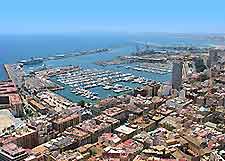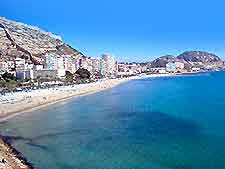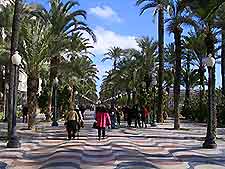Alicante Tourist Information and Tourism
(Alicante, Costa Blanca, Spain)

A city with a true Spanish flavour, Alicante stands on the country's eastern Mediterranean coastline, along the famed Costa Blanca. Often known locally as simply 'Alicant', the city of Alicante stands in the Valencia region of Spain and is the area's second-biggest city.
Alicante is known for its seafront promenades and wide esplanades, such as Alicante's impressive Rambla Méndex Núnez, where al fresco dining abounds. With a renovated historic Old Quarter (El Barrio), many long and sandy beaches and a favourable year-round climate, it is easy to see why Alicante has become such a desirable tourist destination. Alicante also offers endless sightseeing opportunities and an array of seasonal events, with June's Las Hogueras fiesta being a definite highlight.
The Alicante tourism industry actively promotes the city and surrounding area at every opportunity, with the main tourist information bureau being the well-placed Regional Alicante Tourist Information Office along the Rambla de Méndez Núnez. Here you will find an extensive selection and in-depth information about Alicante's many tourist attractions, museums, galleries, shopping centres and districts, with supporting leaflets. Further tourism kiosks, city maps and booklets can be found around the city. The main districts and neighbourhoods in Alicante include the Old Quarter (El Barrio) - which is full of historic buildings and centred around Mount Benacantil; La Zona - close to the Explanada de Espana and known for its restaurants and nightlife; and the El Puerto district of Alicante - where shopping centres, bars, entertainment venues and clubs abound.

With a wealth of accommodation to choose from, many of Alicante's most popular hotels line the seafront, near to the beaches and offering coastal views, particularly around the Plaza Puerta del Mer, where a number of desirable hotels overlook the marina. Alicante also offers a good selection of hotels throughout the Old Quarter and the city centre - around the Plaza del Ayuntamiento, and in the city's outskirts, where hotels are generally at their cheapest, especially during the weekends. Further hotels can be found next to Alicante Airport (ALC), standing on the southwestern side of the suburbs. Although accommodation in Alicante is plentiful, hotels quickly become fully booked in the high season, during both July and August. More information about
Alicante Hotels.
Alicante's main tourist attractions include its exciting nightlife - Alicante is known for its endless selection of restaurants, tavernas and places to eat, which often feature outdoor terraces and a party atmosphere; the main marina - a lively area of Alicante, with many waterfront tourist attractions, harbour cruises and seafood restaurants; San Juan Beach - a huge stretch of sand which has become the city's top beach spot, known locally in Alicante as the 'La Playa de San Juan'; Alicante's Teatro Principal - a notable entertainment venue featuring many regular theatrical performances, concerts and Alicante festivals; and the Plaza del Puerto Viejo - a major public square surrounded by shops, bars and historical buildings, with many outdoor festivals.

Further popular tourist attractions and landmarks in Alicante include the Catedral de San Nicolás de Bari - a historic and eye-catching cathedral with a Renaissance-style façade, large dome and particularly ornate cloister; Castillo de Santa Bárbara - a famous 9th-century castle which overlooks much of the Alicante area and has become one of the area's most prominent landmarks; Church of Santa Maria - Alicante's oldest church, dating back to the 14th century; and the Ayuntamiento - Alicante town hall, a Baroque-style building with twin towers and a highly decorated interior, hosting many seasonal events. More information about
Alicante Tourist Attractions and
Alicante Landmarks.
Some of Alicante's main museums and art galleries include the Archaeological Museum of Alicante (MARQ) - situated in Alicante's former Hospital de San Juan de Dios, with many important local artefacts and in-depth information about the history of the area; and Alicante's Museo Bellas Artes Gravina (MUBAG) - the Museum of Fine Arts, containing a vast collection of art works, displaying over 500 paintings, with changing exhibits. More information about
Alicante Museums and Art Galleries.
Tourist attractions located nearby Alicante include the world-famous tourist resort of Benidorm - an extremely popular coastal resort, full of coastal hotels, entertainment venues and sandy beaches; the city of Valencia - a superb tourist destination, famous for its contemporary City of Arts and Science and enormous university complex; the Balearic Islands - including the party of island of Ibiza, which can be reached by regular ferries and is home to more than 50 beaches and year-round sunshine; the town of Calpe - standing on Alicante's northern outskirts, known for its giant rock, the 'Penon de Ifach', which is now an important nature reserve; Denia - a busy holiday resort with an 11th-century castle and in excess of 20 km / 13 miles of beaches; and Tabarca Island - a noteworthy Marine Reserve, close to Alicante's southeastern side, with panoramic views of the surrounding area. More information about
Alicante Attractions Nearby.
More Alicante Information / Fast Facts and Orientation
- Country: Spain
- Location: Costa Blanca / Alicante, Valencia Community
- Status: city
- Area: approximately 78 square miles / 201 square kilometres
- Population: approximately 323,000
- Language: Spanish
- Currency: Euro (EUR)
- Time zone: 1 hour ahead of Greenwich Mean Time (GMT)
- Country dialing code: +34
- Telephone area code: 96
- Religion: various religions
- Average daily Alicante January temperature: 13°C / 55°F
- Average daily Alicante July temperature: 27°C / 81°F
 A city with a true Spanish flavour, Alicante stands on the country's eastern Mediterranean coastline, along the famed Costa Blanca. Often known locally as simply 'Alicant', the city of Alicante stands in the Valencia region of Spain and is the area's second-biggest city.
A city with a true Spanish flavour, Alicante stands on the country's eastern Mediterranean coastline, along the famed Costa Blanca. Often known locally as simply 'Alicant', the city of Alicante stands in the Valencia region of Spain and is the area's second-biggest city. With a wealth of accommodation to choose from, many of Alicante's most popular hotels line the seafront, near to the beaches and offering coastal views, particularly around the Plaza Puerta del Mer, where a number of desirable hotels overlook the marina. Alicante also offers a good selection of hotels throughout the Old Quarter and the city centre - around the Plaza del Ayuntamiento, and in the city's outskirts, where hotels are generally at their cheapest, especially during the weekends. Further hotels can be found next to Alicante Airport (ALC), standing on the southwestern side of the suburbs. Although accommodation in Alicante is plentiful, hotels quickly become fully booked in the high season, during both July and August. More information about Alicante Hotels.
With a wealth of accommodation to choose from, many of Alicante's most popular hotels line the seafront, near to the beaches and offering coastal views, particularly around the Plaza Puerta del Mer, where a number of desirable hotels overlook the marina. Alicante also offers a good selection of hotels throughout the Old Quarter and the city centre - around the Plaza del Ayuntamiento, and in the city's outskirts, where hotels are generally at their cheapest, especially during the weekends. Further hotels can be found next to Alicante Airport (ALC), standing on the southwestern side of the suburbs. Although accommodation in Alicante is plentiful, hotels quickly become fully booked in the high season, during both July and August. More information about Alicante Hotels. Further popular tourist attractions and landmarks in Alicante include the Catedral de San Nicolás de Bari - a historic and eye-catching cathedral with a Renaissance-style façade, large dome and particularly ornate cloister; Castillo de Santa Bárbara - a famous 9th-century castle which overlooks much of the Alicante area and has become one of the area's most prominent landmarks; Church of Santa Maria - Alicante's oldest church, dating back to the 14th century; and the Ayuntamiento - Alicante town hall, a Baroque-style building with twin towers and a highly decorated interior, hosting many seasonal events. More information about Alicante Tourist Attractions and Alicante Landmarks.
Further popular tourist attractions and landmarks in Alicante include the Catedral de San Nicolás de Bari - a historic and eye-catching cathedral with a Renaissance-style façade, large dome and particularly ornate cloister; Castillo de Santa Bárbara - a famous 9th-century castle which overlooks much of the Alicante area and has become one of the area's most prominent landmarks; Church of Santa Maria - Alicante's oldest church, dating back to the 14th century; and the Ayuntamiento - Alicante town hall, a Baroque-style building with twin towers and a highly decorated interior, hosting many seasonal events. More information about Alicante Tourist Attractions and Alicante Landmarks.